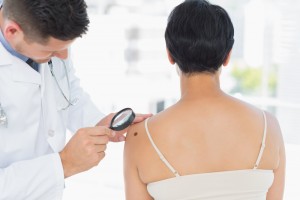 Researchers from the QIMR Berghofer Medical Research Institute, Brisbane, Australia, have published a study in the Journal of Investigative Dermatology, titled “More people die from thin melanomas (<1mm) than thick melanomas (>4mm) in Queensland, Australia”, showing that in terms of absolute numbers, there are more people dying from thin melanomas (less than one millimetre) than thick melanomas (greater than four millimetres).
Researchers from the QIMR Berghofer Medical Research Institute, Brisbane, Australia, have published a study in the Journal of Investigative Dermatology, titled “More people die from thin melanomas (<1mm) than thick melanomas (>4mm) in Queensland, Australia”, showing that in terms of absolute numbers, there are more people dying from thin melanomas (less than one millimetre) than thick melanomas (greater than four millimetres).
After surgical removal, melanoma thickness in the skin is measured by a specialized pathologist. Usually, as these dermatologic malignancies become thicker, the probability of becoming metastatic exponentially augments.
According to study author Professor David Whiteman, even though thick melanomas are associated with a poor prognosis and discouraging survival rates, they constitute only a small percentage of all melanomas diagnosed in Queensland.
“We found the huge increases in the numbers of thin melanomas being detected means that, overall, they account for more melanoma deaths than thick tumours.” explained Prof. Whiteman in a QIMR news release.
Researchers consulted Queensland Cancer Registry data, and analyzed more than 4,000 melanoma deaths in a time period ranging from 1990 to 2009.
They observed that from 1990 to 1994, 14% of all melanoma deaths were due to thin melanomas, a value increasing to 23% from 2005 to 2009. Additionally, in the first five years, 11% of melanoma deaths were cause by thick melanomas, increasing to 14% in the last five.
Even though there is only a small percentage of patients dying from thin tumors, the number of cases has raised significantly, consequently increasing the total number of deaths observed.
“This research highlights the message that all melanomas are potentially dangerous. The statistics should serve to remind us that vigilance is essential to ensure that all melanomas are diagnosed as early as possible, or even better, prevented altogether,” Prof. Whiteman explained.
Katie Clift Cancer Council Queensland (CCQ) spokesperson, whose institution also participated in the research, added, “Queensland has the highest rate of skin cancer in the world. Research shows that prevention messages are driving down rates of invasive melanoma in young Queenslanders. This research reinforces the necessity for all Queenslanders to get to know their own skin and if they notice a new or changed spot or lesion, to visit their GP immediately. Early detection by self-examination or having a doctor check your skin is vital to reduce the burden of melanoma.”


